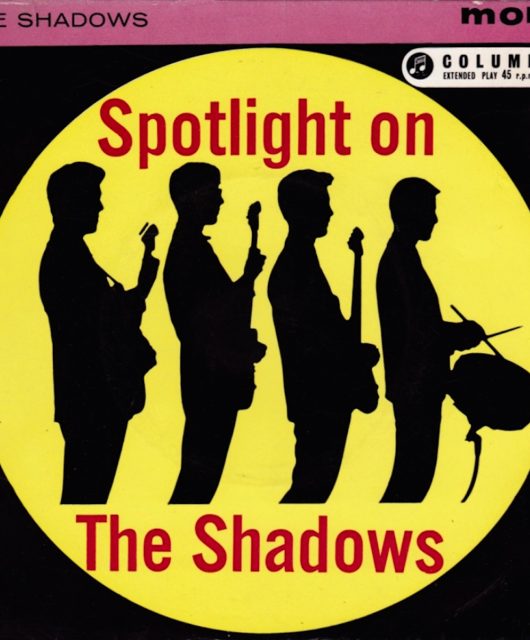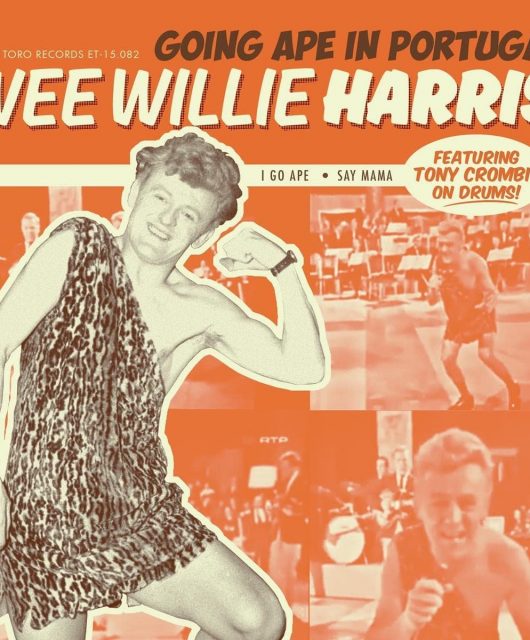A musical snapshot of a man at the apex of his powers, 1957’s indispensable LP Here’s Little Richard combined all of Little Richard’s early Specialty hits up until 1957, and remains his highest-charting long-player to date – Words by Jack Watkins
Richard Wayne Penniman, aka Little Richard, was the man who put the camp into rock’n’roll. Promoters announced him as “the Georgia Peach”, and he declared himself “the Bronze Liberace”. While his raucous singing could rival that of any self-respecting blues shouter, he offset the machismo with effeminate squeals and pleading high notes. Physically, he cut an outrageous figure. He sported a six-inch pompadour from which tresses would break loose as he bobbed and jerked his head around to the music. He exaggerated his already exotic looks by wearing mascara which emphasised his flashing eyes and wide smile. Jerry Lee Lewis recalled that once, when sharing the bill with his fellow manic exponent of boogie-woogie piano, he had to wipe nail-polish off the keys.
If parents of the mid-’50s were horrified by Little Richard’s gender-bending persona, kids just laughed and lapped it up, rejoicing in the antics of a generous, fun-loving free spirit. Arguably, he did more to break down racial barriers for a certain generation than any amount of civil rights protests in the years that followed.
The fact that no-one encapsulated the visual thrill of early rock quite like the man from Macon, Georgia, has tended to obscure the quality of his recorded material, and that’s a mistake. For all his brash, boisterous on-stage energy, Little Richard’s debut album from 1957, Here’s Little Richard, is a period piece that plays like a house-wrecker even today.
Brash & Boisterous
The record deserves revaluation, as there’s a sense that Little Richard has never quite received his critical dues. True, his time at the top as a creative hit-maker was sadly brief, spanning two years between 1956 and 1958, by which time he’d “found God” and become a preacher. It’s also true that his music lacked diversity: he had little of Chuck Berry’s lyrical wit, and wasn’t quite in Jerry Lee’s league as a piano player. Neither did he share Buddy Holly’s fascination with experimenting with sound and musical forms. But if you want the supreme example of take-no- prisoners rock, with no filler, no slowing down for an intake of breath, just drop Here’s Little Richard onto the turntable and listen to the boy go.
The LP, released in March 1957 by the small independent label Specialty, is by far Little Richard’s biggest-selling album, reaching No.13 on the Billboard chart that spring. While it doesn’t include subsequent hit singles like Lucille or Good Golly, Miss Molly, it’s an unfettered expression of Little Richard’s mad genius, backed by choice New Orleans sidemen, recorded at a time when rock’n’roll was at its absolute creative and commercial height.
Wop-Bop-A-Loo-Bop, A-Wop-Bam-Bam!
It kicks off with Tutti Frutti, Little Richard’s breakthrough single and a key song in any account of the genesis of popular music. It’s sometimes been written as if Little Richard chanced upon the rapturous, exclamatory opening – “Wop-bop-a-loo-bop, a-wop-bam-bam!” – in a revelatory moment in the recording booth during his first session for Specialty, at the J&M Studios, run by Cosimo Matassa, in 1955.
In fact, a racier version of the song had been part of his live repertoire for some time, but he’d never thought that it would make a hit. “I’d been singing Tutti Frutti for years, but it never struck me as a song you’d record,” he told biographer Charles White. He’d just used it as a throwaway to loosen up audiences, who roared at the ribald lyrics. But when it came to making records, as he explained to White, “I didn’t go to New Orleans to record no Tutti Frutti.”
Ready To Rock’n’Roll
When he arrived at Art Rupe’s Specialty, he was already hardened by several years on the road. Probably, he was intent on graduating to serious R&B, in the manner of one of his favourites, Fats Domino. Yet Little Richard had been markedly different even while he’d been building up a following on the club scene in Georgia and Mississippi in the early 1950s. Bandleader Johnny Otis recalled catching his act in Houston, walking in to see “this outrageous person, good-looking and very effeminate, with a big pompadour. He started singing and he was so good… he reminded me of Dinah Washington… when he got through he remarked: ‘This is Little Richard, King of the Blues,’ and then he added, ‘and the Queen, too.’”
Little of this had transmitted itself on Little Richard’s early recordings. Sides cut for RCA in 1951/’52 and Don Robey’s Peacock label in 1953, where he worked with Otis, only hinted at the hard-driving R&B he would come to perfect. At Specialty, Art Rupe had been looking for someone who’d provide a “big band sound expressed in a churchy way”. Rupe and producer Robert ‘Bumps’ Blackwell thought they’d found it when they listened to a tape that Richard had sent them. But at that first session at the J&M Studios, Blackwell recalled, the future star may have turned up looking like Tarzan, but he came through the speakers sounding like Mickey Mouse.
A dismayed Blackwell decided to call a break, and took his nervous new recruit and the rest of the recording crew off to lunch. Little Richard started fooling around on an old piano, “like any other ham”, in Blackwell’s description, and fell into a rendition of Tutti Frutti.
All Killer
In an instant Blackwell recognised the unique bawling style he’d so liked on the demo tape. He got writer Dorothy LaBostrie, who was present, having contributed one of the songs to the hitherto lacklustre session, to clean up the words. Richard was allowed to accompany himself on the piano, and with one mic placed next to him and another inside the piano, it took just 15 minutes and three takes to record. By the time it appeared on Here’s Little Richard, it had already given him a first hit single, reaching No.17 on the Billboard Hot 100 chart in January 1957.
The lyrics of another killer track, Long Tall Sally, came courtesy of a little girl named Enotris Johnson, who’d walked a vast distance across the state of Mississippi to the J&M Studios to present the song so she could earn money to support her sick aunt in hospital. Lacking a melody, Little Richard and Blackwell were at first unenthusiastic, but they loved lines like Uncle John and Long Tall Sally having to “duck back in the alley”.
Rip It Up!
Little Richard’s fraught delivery was deliberately speeded up with the intention of frustrating Pat Boone, whose tamer version of Tutti Frutti had outsold the original. It didn’t succeed, but at least this time Boone’s cover didn’t outsell Little Richard’s version, which was also notable for being the first time he recorded one of his trademarks, the exultant, extended scream “Oooooh!!”
It’s been said that Little Richard’s records had little time for the usual boy-meets-girl-sentiments common in that period. In fact, at least one track, Rip It Up – “Saturday night and I just got paid/ Fool about my money, don’t try to save” – did capture teenage feelings of living in the moment, but primarily, his song content was earthier and more in the tradition of black R&B performers whose music had been confined to what had been known as the “race chart”.
A lot of the singers on that chart sounded like they’d swallowed a packet of nails, and Little Richard was similarly raucous. But he spiced it up, ratcheting up the pace, energy and noise levels. This, combined with his image of – in Charles White’s words – the “way-out demento”, was intensely appealing.
Pedal To The Metal
Here’s Little Richard is pretty much pedal to the metal all the way through, but some tracks are more “demento” than others. Even by his own histrionic standards, Jenny, Jenny is fruitcake-wild on the scale of Screamin’ Jay Hawkins. Little Richard sounds so keyed up, he barely bothers finishing off a line before bouncing into the next one. Ready Teddy hit the ground running, and just seeming to get faster.
True Fine Mama was the sort of R&B number The Dominoes might have recorded, but it had a great backbeat and Little Richard was in top squawking form. I Can’t Believe You Wanna Leave, written by Lloyd Price’s brother Leo, was almost stately in pace in the style of Fats Domino, but Little Richard’s high-strung energy wound up tension and excitement to the max.
Maestro Of Mayhem
Alongside Little Richard’s frenzied vocals, a key element of the sound on these songs was the support of top Crescent City session men, especially Earl Palmer on drums, Lee Allen on tenor sax and Alvin ‘Red’ Tyler on baritone sax. They were veterans of sessions with the relatively sedate Fats Domino, but they were energised by Little Richard, so Ready Teddy and Jenny, Jenny featured blizzards of sax playing and an irresistible rhythm.
Little Richard reckoned Palmer and Allen were two of the greatest session musicians of all time, but he also expressed regret that Rupe and Blackwell didn’t let him make the records using his own band, the Upsetters, who backed him on his live shows. “That,” he reckoned, “would have been the most exciting rock’n’roll of all.” The maestro of mayhem may not have been far wrong, for on one track on Here’s Little Richard he was allowed to use those musicians, recorded in Hollywood, on She’s Got It. With blazing saxophone, mad drumming and a pounding piano, it roars off like a train thundering downhill with the brakes off. It’s a blistering closer to an LP once chosen by Rolling Stone as one of the 100 Best Debut Albums Of All Time.
Check out our Little Richard Fan Pack here
Read More: Little Richard Is Back






